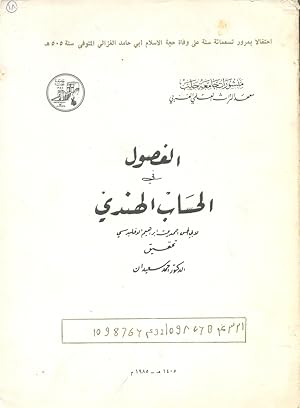Al Iqlidisi Ahmad Ibn Ibrahim Edited (1 results)
Product Type
- All Product Types
- Books (1)
- Magazines & Periodicals
- Comics
- Sheet Music
- Art, Prints & Posters
- Photographs
- Maps
-
Manuscripts &
Paper Collectibles
Condition
- All Conditions
- New
- Used
Binding
- All Bindings
- Hardcover
- Softcover
Collectible Attributes
- First Edition
- Signed
- Dust Jacket
- Seller-Supplied Images
- Not Printed On Demand
Seller Location
Seller Rating
-
Kitab al-Fusul fi al-Hisab al-Hindi.
Published by University of Aleppo., Aleppo, 1984
Seller: Kutub Ltd, London, United Kingdom
Book
Original Wrappers. Condition: Very Good. Second Edition. 4 to, 536 pp of Arabic text, publisher's original stapled wrappers, Spine slightly torn on the top and bottom, cover slightly soiled otherwise copy clean and in very good condition, index, Edited by Dr Ahmad Saidan, Sources and studies in the history of Arabic-Islamic Science, Mathematics, Series 2, Institute for the history of Arabic Mathematics, University of Aleppo, Aleppo ( Syria), Second Edition. As background, Al-Iqlidisi ("the Euclidian") was an Arab mathematician whose Kitab al-Fusul Fi Al-Hisab al-Hindi (The Book of Chapters on Hindu Arithmetic) is the earliest known Arabic work discussing the positional use of the Hindu-Arabic numerals. This treatise on arithmetic is in four parts. The aim of the first part is to introduce the Hindu numerals, to explain a place value system and to describe addition, multiplication and other arithmetic operations on integers and fractions in both decimal and sexagesimal notation. The part second collects arithmetical methods given by earlier mathematicians and converts them in the Indian system. For example the method of casting out nines is described. The third part of the treatise tries to answer to the standard type of questions are asked by students: why do it this way . ?, how can I . ?, etc. There is plenty of evidence here that al-Iqlidisi must have been a teacher, for only a teacher would know understand the type of problem that a beginning student would encounter. The fourth part has considerable interest for it claims that up to this work by al-Iqlidisi the Indian methods had been used with a dust board.A dust board was used because the methods required the moving of numbers around in the calculation and rubbing some out as the calculation proceeded. The dust board allowed this in the same sort of way that one can use a blackboard, chalk and a blackboard eraser. However, al-Iqlidisi showed how to modify the methods for pen and paper use. #23599.


